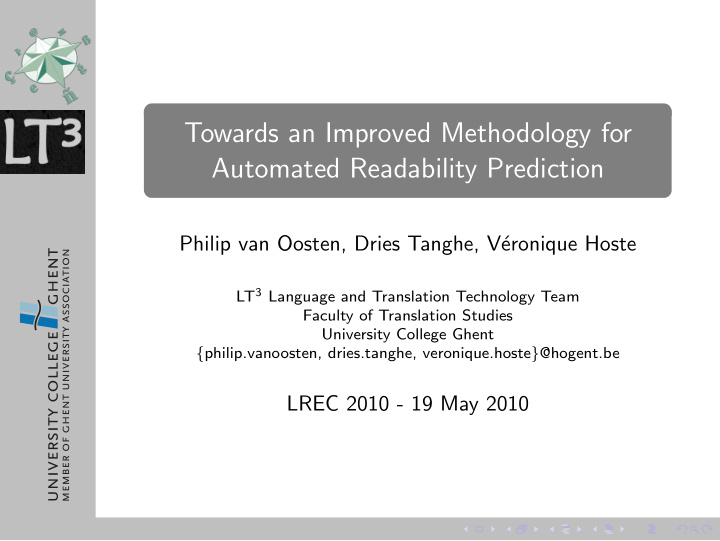



Towards an Improved Methodology for Automated Readability Prediction Philip van Oosten, Dries Tanghe, V´ eronique Hoste LT 3 Language and Translation Technology Team Faculty of Translation Studies University College Ghent { philip.vanoosten, dries.tanghe, veronique.hoste } @hogent.be LREC 2010 - 19 May 2010
Outline Introduction: the concept of readability (prediction) 1
Outline Introduction: the concept of readability (prediction) 1 Experiments on large corpora 2
Outline Introduction: the concept of readability (prediction) 1 Experiments on large corpora 2 Discussion 3
Outline: introduction Introduction: the concept of readability (prediction) 1 Experiments on large corpora 2 Discussion 3
Introduction: readability What is readability?
Introduction: readability What is readability? “The characteristic of text that makes readers willing to read on.” [McLaughlin1969]
Introduction: readability What is readability? “The characteristic of text that makes readers willing to read on.” [McLaughlin1969] “The reading proficiency that is needed for text comprehension.” [Staphorsius1994]
Introduction: readability What is readability? “The characteristic of text that makes readers willing to read on.” [McLaughlin1969] “The reading proficiency that is needed for text comprehension.” [Staphorsius1994] “What makes some texts easier to read than others.”[DuBay2004]
Introduction: readability prediction What is readability prediction? Automated analysis of an unseen text Result: readability assessment score grade level ranking Sometimes used for assistance in writing process
Introduction: readability prediction What is readability prediction? Automated analysis of an unseen text Result: readability assessment score grade level ranking Sometimes used for assistance in writing process What is a readability formula? A readability prediction method Mathematical formula consisting of constants → weights; variables → text characteristics. e.g. Flesch Reading Ease [Flesch1948]: 207 - avgsentencelen - 85 * avgnumsyl
Introduction: content of our paper In-depth analysis of 12 existing readability formulas Behaviour when tested on large corpora: correlation matrices Principal Component Analysis (PCA) Methodological (in)validity: collinearity tests
Introduction: content of our paper In-depth analysis of 12 existing readability formulas Behaviour when tested on large corpora: correlation matrices Principal Component Analysis (PCA) Methodological (in)validity: collinearity tests Our findings Readability formulas are more or less interchangeable all formulas are based on a limited set of variables regardless of the language for which they were designed (English, Dutch, Swedish)
Outline: experiments Introduction: the concept of readability (prediction) 1 Experiments on large corpora 2 Correlation matrices Principal Component Analysis Collinearity tests Discussion 3
Large-scale calculation of readability scores and text characteristics Data sets Dutch Corpora Eindhoven Corpus : 740k tokens, 5k fragments SoNaR : 81M tokens, 213k texts English Corpora Penn Treebank : 1M tokens, 2.5k texts British National Corpus : 85M tokens, 3.1k texts
Correlation matrices Calculated correlations between characteristics – characteristics characteristics – formulas formulas – formulas
Correlation matrix Formulas: upper / left Characteristics : lower / right light green: ρ > 0 . 8 dark green: 0 . 8 ≥ ρ > 0 . 6
Observations Formulas correlate strongly with each other
Observations Formulas correlate strongly with each other Regardless of language No adaptation, only rescaling
Observations Formulas correlate strongly with each other Regardless of language No adaptation, only rescaling Formulas correlate strongly with word length
Principal Component Analysis The goal of PCA possibly correlated variables → uncorrelated variables latent factors ≈ maximal variance
Principal Component Analysis The goal of PCA possibly correlated variables → uncorrelated variables latent factors ≈ maximal variance Performed PCA on all readability scores on all text characteristics
wsj − Readability formulas 8 6 Variances 4 2 0 Latent factors
wsj − Text characteristics 4 3 Variances 2 1 0 Latent factors
Collinearity tests [Belsley et al.1980] Determining the interdependence of variables in a formula Readability formulas < multiple regression Collinearity: variables are correlated found in all formulas → extrapolating to other data can be problematic
Outline: discussion Introduction: the concept of readability (prediction) 1 Experiments on large corpora 2 Discussion 3
Towards an improved feature selection Features that are used Strongly overlap Language-independent Strictly superficial
Towards an improved feature selection Features that are used Strongly overlap Language-independent Strictly superficial Features that should be used On several levels lexis, syntax, structural Language-dependent e.g. compounding in Dutch Underlying causes of readability e.g. cohesion and coherence
Towards an improved methodology Existing readability formulas constructed and validated by means of limited corpora typically a few hundred texts based on a single method of readability assessment standard reading tests
Towards an improved methodology Existing readability formulas constructed and validated by means of limited corpora typically a few hundred texts based on a single method of readability assessment standard reading tests Future readability prediction methods validation against large corpora embedding in corpus research based on different kinds of readability assessment collecting assessments from reading community
References David A. Belsley, Edwin Kuh, and Roy E. Welsch. 1980. Regression Diagnostics: Identifying Influential Data and Sources of Collinearity . Wiley, August. William H. DuBay. 2004. The Principles of Readability . Impact Information. Rudolph Flesch. 1948. A new readability yardstick. Journal of Applied Psychology , 32(3):221–233. G. Harry McLaughlin. 1969. SMOG grading – a new readability formula. Journal of Reading , pages 639–646. Gerrit Staphorsius. 1994. Leesbaarheid en leesvaardigheid. De ontwikkeling van een domeingericht meetinstrument. Cito, Arnhem.
Recommend
More recommend